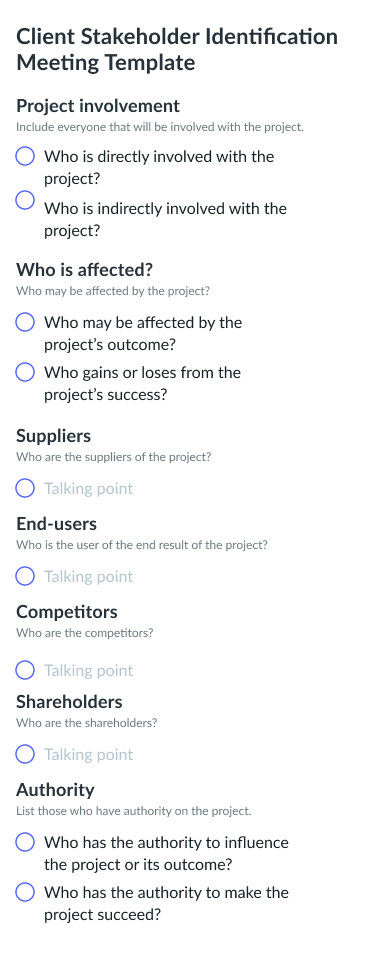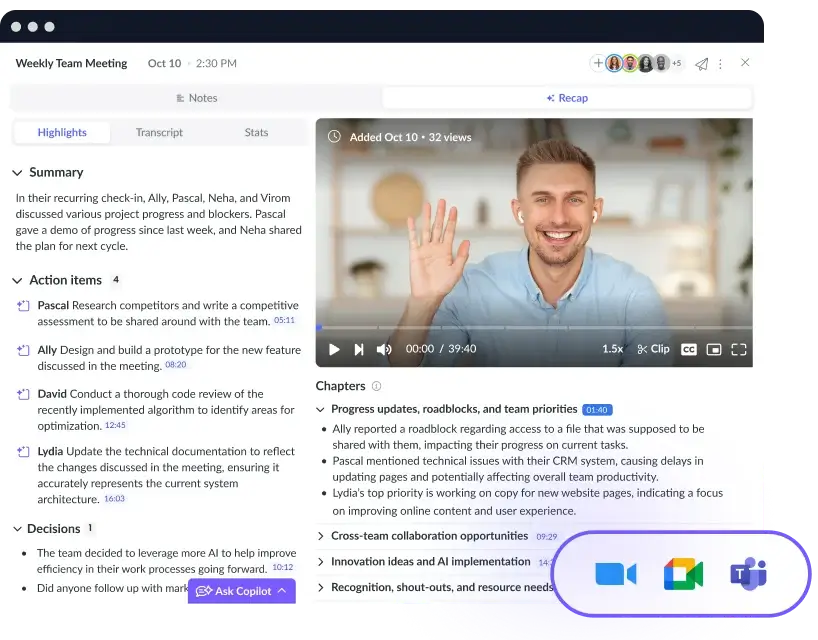Client Meeting 101: 6 Tips on How to Plan and Execute [+ Free Templates]
Client meetings can be fun but stressful. These tips on how to plan and run your client meetings can make them a total cakewalk.
Whether you’re pitching a prospective client or checking in with a trusted partner, there’s a line to walk. Should you be formal, or can you go more casual? How much of the client’s time can you take before you’re imposing on them? The below tips on how to plan and execute client meetings can help you answer all these questions and more.
- What are the types of client meetings?
- Who is invited to client meetings?
- 6 tips on how to plan and execute client meetings
- Free client meeting agenda template
What are the types of client meetings?
The types of client meetings are pretty much limitless. You could meet with a new client to get started, or you could meet a longtime client for a delicious dinner that helps build rapport. Most client meetings, though, fall into the below four categories.
1 Consultation
A consultation is a meeting with a prospective client to learn all their wants and needs. You could also consult with a current client interested in using more of your services. But you’re not holding a sales meeting – it’s a consultation. That means your purpose isn’t to push a hard sell for yourself. Instead, you should simply listen to the client’s needs and show that you understand them. Afterward, you can come up with a brilliant plan to sell the client.
2 Introductory meeting
An introductory meeting is a sit-down with a new client, or a current client if you’re their new account manager. It’s basically a “getting to know you” kind of situation. You’re there to figure out how you two can best work together and start things off on the right foot. Your goal is to build trust in a way that makes future meetings smooth as butter.
3 Proposal meeting
At your proposal meeting, you’ll get into the solution you came up with after the consultation. And sure, that kind of thing can be nerve-wracking. But if the client has made time for you to fully pitch them, it’s because they’re interested! Be confident – make eye contact, don’t speak too fast, things like that – and you might just make the sale after all.
4 Check-in
If you’re having check-ins, congrats – you’ve turned a potential client into an actual one! During these meetings, you’ll update your client on the work you’re doing for them. You can also see whether they need more of the services you offer. Check-ins are your chance to upsell clients, but it’s also so much more than another way to make money. Regular check-ins improve your client relationships, build loyalty, and work toward transforming clients into all but partners.
Who is invited to client meetings?
Client meetings aren’t always one-on-one meetings. In fact, you might fare better bringing someone from your team with you. Showing up with another person from your team can give the impression of a big team that always has the capacity for your client’s needs. You should bring someone with whom your clients will actually interact rather than a team member you randomly pluck from the office.
The client with whom you speak might be an account manager, a department head, or another role that involves speaking with potential vendors. The client might also be more than one person – you could be speaking with a group of people representing the same company. When a few people from both sides of the table show up, more ideas can flow, and you can more easily build trust.

Client meetings worth showing up to
A well-run client meeting can foster communication and collaboration by including an agenda the whole team can contribute to. Try using a tool like Fellow!

6 tips on how to plan and execute client meetings
Client meetings can occasionally seem stressful. After all, it definitely stings a bit when you put a bunch of time and work into a sale that doesn’t go through. Or maybe you’re worried that a current client will complain about the quality of your work. In any case, properly planning for and executing your meeting can make the whole thing so much easier. Here’s how to do both.
- Research everything and bring any documents you need
- Be clear on your goals
- Write and share a straightforward meeting agenda
- Stick to your agenda so you can avoid distractions
- Be flexible when it makes sense
- Decide your next steps
1 Research everything and bring any documents you need
Let’s say you’re meeting with a potential client and you show that you don’t know much about the client’s company or pain points. Sounds like the wrong place to start from, right? That’s why you should research the client’s company, industry, background, and network. Chances are you won’t be able to find everything, and that’s okay. In that case, bring a list of questions to the meeting to show the client you’re interested in them and their needs.
This list of questions is just one document you should bring to a potential meeting. You should also bring any relevant sales decks or presentations. You don’t necessarily need to print these items – just have your laptop ready to go and know where you’ve stored the files. This tip can come in handy for meeting with current clients too. Searching for documents you could’ve pulled up beforehand is a poor use of the client’s time.
2 Be clear on your goals
Surely, you’ve heard the phrase, “This meeting could’ve been an email.” You never want to hear that from a client. You can also avoid it if you clearly define your meeting purpose for both yourself and your client well ahead of time. Looking to pitch a prospect on being their vendor for a service you think is missing from their roster? Say so. Need to get clarity on a new recurring task from a longtime client? Make that clear too. Doing so tells the client why you’re asking for their time and helps ground you during your meeting.
3 Write and share a straightforward meeting agenda
A good meeting agenda is the backbone of any great business meeting, client or otherwise. When you create an agenda, you clearly state what topics you intend to cover and for how long. You also leave space for you and the client to ask each other questions. You should send your meeting agenda to the client before you start the meeting.
If you’re speaking with a longtime client, you can keep your agenda pretty informal – just a loose running order with some broad topics. For an initial meeting with a prospect, you might want to impress them with a formal outline of topics and discussion times for each. Bonus points if you keep the meeting to half an hour.
4 Stick to your agenda so you can avoid distractions
Getting off track from the agenda can happen at any meeting. A client meeting is an especially unfortunate time to run into this meeting obstacle – wasting a client’s time is never a good move. That’s why you should make an especially strong effort to stick to your plan. Otherwise, you risk running into distractions that could make the whole meeting a lot tougher.
For starters, choose a meeting location that minimizes things that could get the whole meeting off track. A loud restaurant, for example, might not be the best for a client meeting where you’re going deep on project details. And then, during the meeting, if anyone present asks questions or raises topics that veer from the agenda, turn them into meeting action items. This way, someone in the meeting can act on the topic afterward and you can stay focused now.
5 Be flexible when it makes sense
Being flexible might seem like the polar opposite of sticking to your agenda, but sometimes, it’ll prove necessary. Let’s say you keep trying to bring things back to the agenda but your client keeps trying to move in a different direction. After enough attempts to reroute things, you might want to follow the client’s lead. Maybe you’ll realize you can better serve the client based on what they’re saying now than what you’d previously heard.
This sort of detour is where the questions portion of your agenda can come in handy. Though it’s often a space for your client to ask questions, you can do the same. If the client is going in a whole different direction, use this part of the agenda to ask questions about that. Then, state that you’ll look into these questions and get back to the client later. When a brand new topic arises in a meeting, you can always explore and answer it afterward.
6 Decide your next steps
You shouldn’t just leave the meeting once you work through your agenda. Take a minute or two to figure out your next steps. Who from your team will do what? Which people from your client’s company will do what? Will you need to meet in person again, can you stick to a phone call, or can you sign a contract without any more meetings?
As you answer these questions, refresh everyone in the room on any open questions and meeting action items. Then, shortly after the meeting, send out meeting notes summarizing this wrap-up and everything else you discussed. Include questions, action items, and next steps in your notes so everyone knows how to move forward. Doing so can get you one step closer to making a sale, completing a project for a big client, or anything in between.
Free client meeting agenda template


Better client meetings today mean better work tomorrow
Getting on the same page as your clients now can help everything go better in the near future. Client meetings are often the best way to achieve this goal. They go even better with Fellow’s tools for creating collaborative meeting agendas, notes, and meeting action items. With these tools, planning for, executing, and following up on client meetings is easier than ever before.











